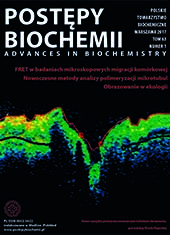Microscopic imaging of calcium ions with genetically encoded calcium indicators
Abstract
Calcium is a second messenger that plays a key role in various cellular processes. Monitoring calcium levels is a prerequisite to their understanding. The first calcium indicators for microscopy were the luminescent protein aequorin and chemical probes. These indicators, however, have serious drawbacks, limiting their use in many types of experiments. Cloning of cDNA for the
A. victoria GFP and creation of its first spectral variants has initiated the development of fluorescent, genetically encoded calcium indicators (GECI). They are composed of a fluorescent protein and a calcium-binding protein, usually calmodulin. The binding of calcium to the sensory domain of the indicator affects the fluorescent properties of the chromophore, which enables recording of calcium signals as fluorescent light. GECIs have many advantages and are essential for conducting long-term experiments in vivo. This article gives an overview of the currently available GECIs, the history of their development, applications and microscopic imaging systems.
Downloads
Published
Issue
Section
License
All journal contents are distributed under the Creative Commons Attribution-ShareAlike 4.0 International (CC BY-SA 4.0) license. Everybody may use the content following terms: Attribution — You must give appropriate credit, provide a link to the license, and indicate if changes were made, ShareAlike — If you remix, transform, or build upon the material, you must distribute your contributions under the same license as the original. There are no additional restrictions — You may not apply legal terms or technological measures that legally restrict others from doing anything the license permits.
Copyright for all published papers © stays with the authors.
Copyright for the journal: © Polish Biochemical Society.




